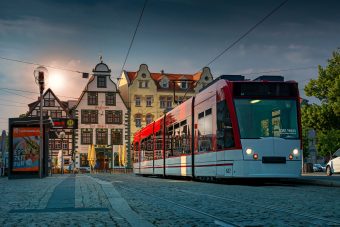
Building large-scale solar farms in northern Victoria part of plan to reduce state’s net carbon emissions to zero by 2050.
Melbourne’s tram network will become entirely solar-powered under a proposal by the Andrews government to build large-scale solar farms in northern Victoria.
The proposal, announced on Thursday, is part of a plan to reduce Victoria’s net carbon emissions to zero by 2050. Tenders to build and operate 75MW of new solar farms will be released in early 2017 and the first solar power plant is expected to be completed by the end of 2018.
The environment and energy minister, Lily D’Ambrosio, said 35MW of the generating power of the new solar plants would be dedicated to running Melbourne’s tram network, which would reduce the city’s greenhouse gas emissions by 80,000 tonnes a year.
“We will use our purchasing power as a large energy consumer to boost investment in renewables and create new jobs for Victorians,” D’Ambrosio said. “We’re positioning Victoria as a leader in climate change, by reducing emissions and adapting to the impacts.”
D’Ambrosio said the project would deliver $150m in capital expenditure to regional Victoria and create 300 jobs.
The Greens welcomed the move to solar-powered trams, saying it matched a Greens policy announced in 2015, but said it was hypocritical of the Andrews government to promote large-scale solar while cutting solar feed-in tariffs.
The minimum solar feed-in tariff was reduced from 6.2 cents a kilowatt hour to five cents a kilowatt hour on 1 January.
“It’s some pretty mixed messages that we’re seeing from the Andrews government when it comes renewables, including the fact that we’re supposed to have a plan on what to do with the coal industry by the end of last year and that hasn’t materialised,” the Greens MP Ellen Sandell said.
D’Ambrosio said the reduction was a hangover from the previous Coalition government, and the feed-in tariff would increase by up to 20% on the current rate from 1 July.
Environment Victoria’s chief executive, Mark Wakefield, said there was symbolic power in having the tram network, which is one of the most recognisable features of Melbourne, powered by renewable energy.
“I would love to see the train network also powered by renewable energy,” he said.
It comes six months after the Andrews government approved the construction of two windfarms in north-west Victoria, the 30MW Kiata windfarm, 50km north-west of Horsham, and the 66MW Mt Gellibrand windfarm, 17km west of Winchelsea.
The proposal follows the announcement in November that the Hazelwood coal-fired power station in Gippsland, which had produced up to 25% of Victoria’s electricity, would close.
The owners of that plant, Engie, are also investigating the possible sale of Loy Yang B coal fire power station in the Latrobe valley, which produces 17% of Victoria’s power. According to a 2015 government report on Victoria’s renewable energy targets, just 12% of Victoria’s electricity supply in 2014 was renewable, while 84% came from coal.
Source: theguardian.com



